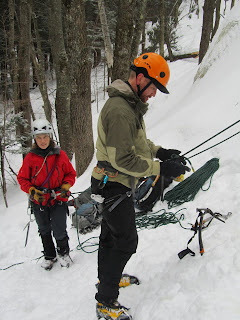 Tucked away behind North Conway, N.H., Cathedral Ledge rises dramatically above its hemlock and white pine neighbors with steep rock ledges. With rock climbing during the summer, ice climbing in winter, this spot is so popular that you might wait a while for your turn to climb.
Tucked away behind North Conway, N.H., Cathedral Ledge rises dramatically above its hemlock and white pine neighbors with steep rock ledges. With rock climbing during the summer, ice climbing in winter, this spot is so popular that you might wait a while for your turn to climb.It took me one year to gather my courage and commit to ice climbing. I wanted to attempt it last year, but chickened out. This year, I purchased two spots in an EMS class, Intro to Winter Climbing (learning the basics of ice climbing and mountaineering) for the man's birthday. I packed a bag full of clothing layers and food. I like to be warm and well-fed, obviously.
After being fitted for our technical gear at the EMS store in town (gear including mountaineering boots, harness, belay device, carabiners, helmets, ice axe, mountaineering axe, crampons), we headed to the ledge for our day-long lesson.
Bulges of yellow and white snow-packed ice awaited, divots from previous climbers showing us the thicker ice to climb and avoid the thinly covered rocks that are the real gear-killers. Snow still lightly covered the hemlock needles, creating a cheery winter scene despite the light misting drizzle that started.
 Our lesson began first with learning to climb in boots that do not allow your ankles to flex, a task tougher than you might think. Duck walk (inner arches pointed forward), French technique (sideways walking uphill), and International technique (front foot jammed straight into hill using crampons, back foot sideways with inner arch pointed uphill) allowed us to get to the ice slabs, layers and layers of ice either attached to rocks or acting as a pillar between rocks. Some of it brittle, some of it strong, we would learn by experience how trustworthy the ice--and our technique--would be. And so we began, with our awesome instructor Sara at the helm.
Our lesson began first with learning to climb in boots that do not allow your ankles to flex, a task tougher than you might think. Duck walk (inner arches pointed forward), French technique (sideways walking uphill), and International technique (front foot jammed straight into hill using crampons, back foot sideways with inner arch pointed uphill) allowed us to get to the ice slabs, layers and layers of ice either attached to rocks or acting as a pillar between rocks. Some of it brittle, some of it strong, we would learn by experience how trustworthy the ice--and our technique--would be. And so we began, with our awesome instructor Sara at the helm. The thing about ice climbing is this: it's really a balancing act more than anything. The gear does most of the work. Sure, you are in charge of ensuring the front of your crampons are securely gripping into the ice for adequate footing. Yes, the axe must be hooked into the ice properly. But you don't need to be in fabulous physical shape to climb. You just need to be well-balanced--ice axe above head, legs spread to form a triangle between the axe and your feet. Swing the pick, kick toes into ice, push up. Repeat.
The thing about ice climbing is this: it's really a balancing act more than anything. The gear does most of the work. Sure, you are in charge of ensuring the front of your crampons are securely gripping into the ice for adequate footing. Yes, the axe must be hooked into the ice properly. But you don't need to be in fabulous physical shape to climb. You just need to be well-balanced--ice axe above head, legs spread to form a triangle between the axe and your feet. Swing the pick, kick toes into ice, push up. Repeat. Thanks to my recent indoor climbing sessions, I've become accustomed to trusting the harness and climbing gear to catch me if I fall. I am now able to look down and around while climbing without any ounce of panic, which is a gigantic step forward for me in conquering my intense fear of heights. This was a fabulous advantage for ice climbing, where the stark beauty of the icy landscape surrounding you is a mental image you'll want to carry with you forever.
Thanks to my recent indoor climbing sessions, I've become accustomed to trusting the harness and climbing gear to catch me if I fall. I am now able to look down and around while climbing without any ounce of panic, which is a gigantic step forward for me in conquering my intense fear of heights. This was a fabulous advantage for ice climbing, where the stark beauty of the icy landscape surrounding you is a mental image you'll want to carry with you forever. I'm not saying it wasn't physically and mentally challenging--it most definitely was both. But for our first time, it wasn't as scary as I thought it would be, and even when I got frustrated, I was still having fun.
I'm not saying it wasn't physically and mentally challenging--it most definitely was both. But for our first time, it wasn't as scary as I thought it would be, and even when I got frustrated, I was still having fun.We ended our lesson with self-arrest techniques to stop ourselves from sliding down a hill and over a cliff in the snow, an extremely important bit of knowledge for winter activities. Once we shed our gear, the man and I headed to Cranmore Mountain for some more fun on the mountain coaster and snow tubing. Hard work should always be followed up by hard play.

1 comment:
I bet you are a great mom. You were an amazing lady.....
Post a Comment